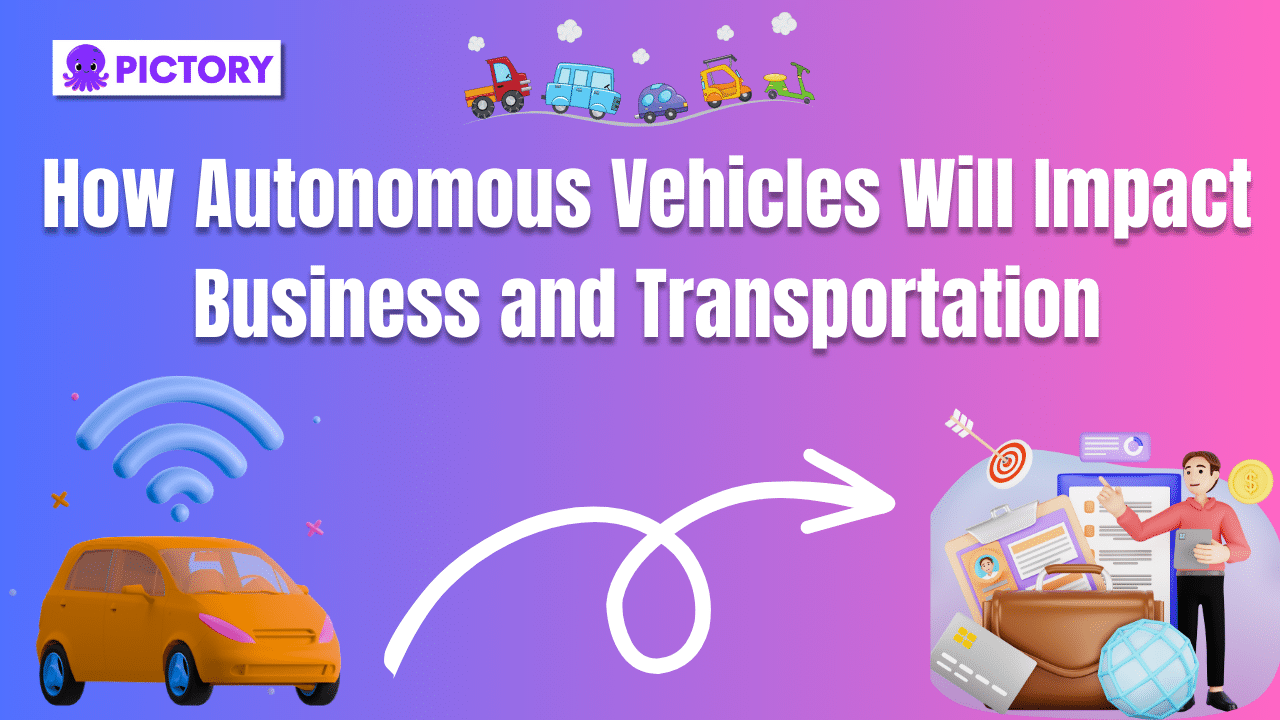Imagine a world where your daily commute is no longer a chore, but an opportunity to relax or catch up on work while your car effortlessly navigates the roads.
This vision is closer to reality than you might think.
Autonomous vehicles (AVs) are poised to revolutionize transportation, business, and daily life.
In this blog post, we’ll explore the far-reaching impacts of AVs, focusing on the future of autonomous vehicles and implications for business and transportation, from transforming industries to redefining urban landscapes and beyond.
Access the power of AI on your desktop with a Pictory account.
Boost your video marketing strategy with text transformed into video in just a few clicks!
Short Summary
Autonomous vehicles are set to revolutionize industries and provide new opportunities and challenges for businesses.
Policymakers must create a legal framework that addresses liability issues, while states develop uniform regulations to ensure safe operation across state lines.
The introduction of AVs has the potential to both displace existing jobs and create new ones with different skill sets requiring workforce development programs.
The Impact of Autonomous Vehicles on Business

As the technology behind the autonomous car advances, we’re witnessing the dawn of a new era in transportation.
One that stands to disrupt various industries and create a wave of opportunities and challenges.
From logistics and supply chains to insurance and the automotive industry, the rise of self-driving cars will undoubtedly affect numerous business models, opening the door for innovation and growth.
Autonomous vehicles, including autonomous cars and driverless vehicles, have the potential to revolutionize the way we move, with implications for safety, thanks to advancements in autonomous vehicle technology and the emergence of self-driving vehicles.
Ride-Hailing Services
Autonomous vehicles are set to stimulate the expansion of ride-hailing services, potentially decreasing car ownership and augmenting individual vehicle usage.
As a result, we could witness a fundamental shift in the way we approach transportation, with fewer privately owned cars on the road and increased reliance on shared mobility services.
This could have a profound impact on traffic flow, as AVs optimize driving patterns and connect to smart city infrastructure, paving the way for more efficient and sustainable urban mobility.
Furthermore, the integration of LiDARs and sensors into autonomous vehicles allows them to navigate complex urban environments, avoid other vehicles, and react instantaneously to prevent collisions.
This enhanced safety, combined with the convenience of on-demand mobility, could make ride-hailing services an increasingly attractive alternative to traditional public transport and car ownership.
Logistics and Supply Chains
The logistics and supply chain industry is on the cusp of a major transformation, as autonomous vehicles and robots promise to increase speed, efficiency, and productivity.
From autonomous drones conducting hazardous tasks, such as inventory counting in high warehouse locations, to self-driving delivery vehicles reducing the cost of last-mile delivery in e-commerce, the potential applications of AVs in supply chain operations are vast.
New business opportunities will emerge in the wake of AV implementation, such as specialized technical training for the current workforce, managing inventories of specialized electronic parts, and providing skilled labor for the repair and maintenance of autonomous vehicles.
Additionally, complementary technologies like routing algorithms, traffic-control systems, and customer interfaces will play a crucial role in the successful implementation of AVs in logistics.
The integration of AVs into logistics and supply chain operations presents an opportunity for companies to:
Capitalize on the wealth of data collected by these vehicles
Optimize processes
Reduce costs
Gain a competitive edge in an increasingly connected and data-driven world.
Insurance
The insurance industry will need to adapt to the rise of autonomous vehicles.
Traditional policies based on driver characteristics and behavior become less relevant.
Insurers must develop new classifications of vehicle insurance that account for the unique risks associated with AVs.
This may involve basing pricing on factors such as:
Vehicle Usage
Type of Activity
Operating System
Safety Standards
Data collection through connected vehicles will play a crucial role in the development of new insurance products and pricing strategies.
Insurers can analyze information such as:
Miles driven
Acceleration
Braking
Other driving habits
By analyzing this data, insurers can design policies that encourage and reward safe driving behavior.
As AV technology continues to evolve, the insurance industry will need to stay agile and responsive to the changing landscape.
Automotive Industry
The automotive industry is at a crossroads, as the rise of autonomous vehicles forces traditional car manufacturers to reassess their strategies and adapt to a software-driven future.
With AVs poised to become more prevalent in the private passenger-car segment by 2025, OEMs and suppliers must adapt their operations, emphasizing software-driven development procedures and providing flexible, comprehensive services across vehicle segments.
This transition will also require automotive manufacturers to revisit their approach to revenue generation.
With the potential for subscriptions, pay-per-use offerings, sales of upgrades, software maintenance, and upselling to more advanced systems, car manufacturers have an array of new revenue streams at their disposal.
As the industry moves toward a more software-centric model, OEMs will need to invest in acquiring new technological competencies, allay safety concerns, and devise new sales and business strategies to stay competitive.
The shift toward autonomous vehicles also presents suppliers with a unique set of challenges and opportunities.
As the industry evolves, suppliers may need to adjust to new success factors, contend with intense competition, and provide varied delivery models to their OEM customers.
By staying nimble and embracing the potential of AV technology, both manufacturers and suppliers stand to benefit from this transformative period in the automotive industry.
Transforming Transportation and Infrastructure

Autonomous cars have the potential to dramatically reshape our transportation networks and infrastructure.
By reducing traffic congestion, increasing road capacity, and integrating with public transportation systems, AVs promise to usher in a new era of efficient and sustainable urban mobility.
AVs can reduce the need for parking spaces, reduce emissions, and improve safety by eliminating human traffic.
If you’re finding this article interesting, why not explore how AI technology is impacting another sector?
Read Virtual Reality TV: How AI Technology is Developing Film and TV Production.
Traffic Congestion
One of the most significant benefits of AVs is their potential to alleviate traffic congestion.
By optimizing driving patterns and connecting to intersection-based systems, AVs can help reduce traffic delays and improve overall traffic flow.
The reservation-based system proposed by Dresner and Stone, for instance, has been noted to perform two to three times better than traditional traffic lights and can effectively manage highly congested traffic conditions.
The implementation of driverless vehicles also has the potential to:
Decrease traffic delays due to a reduction in vehicle collisions
React instantaneously to prevent collisions and maintain a safe distance from other vehicles on the road with advanced sensors and LiDAR technology
Gradually decline traffic congestion as more AVs join the transportation sector
Lead to smoother and more efficient travel for all
Road Capacity

Autonomous vehicles also have the potential to:
Increase road capacity by cruising at higher speeds while maintaining shorter distances between vehicles
Achieve this through techniques such as platooning, which involves groups of AVs traveling closely together in a coordinated manner
Maintain smaller spaces between vehicles, significantly increasing road capacity
Allow for more efficient use of existing road networks
Improving road capacity not only helps alleviate traffic congestion but also contributes to reducing fuel consumption and emissions from vehicles.
As AVs optimize their driving patterns and maintain consistent speeds, fuel economy is improved, leading to lower emissions and a reduced environmental impact.
Public Transportation
Integrating AVs with public transportation systems can lead to more sustainable and efficient urban mobility solutions.
By incorporating AVs into existing public transport offerings, cities can provide a new form of low-capacity, high-quality public transport that complements traditional bus and train services.
This can help reduce the reliance on private vehicle ownership and promote the use of shared and environmentally friendly transport options.
Shared electric AVs, in conjunction with public transport, could effectively reduce both congestion and off-street parking requirements.
Additionally, accessible public transportation can reduce the cost of living for those with convenient access, resulting in savings of around $10,000 per household.
The rise of AVs presents a unique opportunity for cities and transport planners to reimagine their urban landscapes and create more sustainable, efficient, and equitable transportation networks.
By embracing the potential of AVs and integrating them with public transportation systems, we can work towards a greener, more connected future.
Data Management and Security Challenges

As the adoption of autonomous vehicles continues to grow, so too do the challenges surrounding data management and security.
With AVs collecting vast amounts of data on drivers, roads, and traffic patterns, ensuring the privacy and security of this information is of paramount importance.
Data security is a complex issue and one that requires a multi-faceted approach.
Privacy Concerns with Autonomous Vehicles
The data collected by AVs raises concerns about the protection of personal information and GPS location data.
Consumer rights activists have expressed concern over the potential sale of drivers’ personal information to third-party vendors.
This could be detrimental to those involved.
To address these concerns, it is essential to implement measures to secure individuals.
IP addresses, personal information, and GPS location data, ensuring that privacy is maintained in the age of connected vehicles.
Cybersecurity Measures
Ensuring the security of connected vehicles is crucial, as the wireless connectivity of AVs makes them vulnerable to hacking and other cyber threats.
This may result in data breaches, malicious software, and disruptions to services.
To protect against potential cyber threats, robust cybersecurity measures, such as encryption, authentication, and access control, should be utilized to safeguard the data collected by AVs.
Regulatory Landscape and Standardization

The regulatory landscape and standardization for autonomous vehicles are crucial factors in their widespread adoption and integration into daily life.
As AV technology continues to evolve, policymakers must establish clear regulations and address relevant issues, such as guidelines for states and legal liability concerns.
These regulations must be comprehensive and consistent across jurisdictions and must be updated as technology advances.
Guidelines for States Concerning Autonomous Vehicles
Uniform regulations across states are necessary to streamline the design and implementation of autonomous cars.
This will ensure that AVs can operate safely and efficiently across state lines, fostering innovation and growth in the sector.
Organizations like the National Highway Traffic Safety Administration (NHTSA) are expected to release new rules and guidance in the coming years to help establish a coherent regulatory framework for AVs.
However, some states have already imposed limitations on the development and deployment of AVs.
For example, California legislation had mandated that a human driver must be present in the front seat of fully autonomous vehicles and that companies were not permitted to remove human-operated steering wheels and brakes.
These mandates have since been reversed.
These restrictions could potentially diminish some of the advantages of driverless cars and create a hindrance to innovation in the automotive sector.
Legal Liability
As autonomous vehicles become more prevalent, legal liability issues must be addressed.
One potential solution is to shift responsibility from individual drivers to manufacturers, holding them accountable for any accidents or incidents caused by their vehicles.
Another approach is implementing “no-fault” insurance policies, which provide coverage for any damages resulting from an accident, regardless of who is deemed responsible.
By establishing a clear and comprehensive legal framework for AVs, policymakers can ensure that the technology continues to advance safely and responsibly, paving the way for a future where fully autonomous vehicles are an integral part of our transportation networks.
Workforce Implications of Autonomous Vehicles
The workforce implications of autonomous vehicles are both a cause for concern and an opportunity for growth.
On one hand, the rise of AVs may lead to job losses for drivers in various industries, as well as workers in related fields.
On the other hand, the introduction of AVs is likely to create new employment opportunities in technology-related areas, such as software development, data management, and specialized maintenance roles.
These new roles will require a different set of skills than those traditionally associated with driving.
Job Losses
As autonomous vehicles become more commonplace, it is anticipated that there will be a considerable number of job losses among those employed in the following industries:
Trucking
Taxi
Ride-share
Courier
Food-delivery
Warehousing
Manufacturing
While the exact number of job losses is difficult to predict, it is clear that the widespread adoption of AVs will have a profound impact on the workforce.
It is important to recognize that job displacement is not a new phenomenon, as new technologies have historically disrupted industries and reshaped labor markets.
However, the pace and scale of the changes brought about by AVs present a substantial challenge for workers and policymakers alike.
To mitigate the negative impacts of these job losses, it is essential to invest in reskilling and workforce development programs, ensuring that those affected have the opportunity to adapt to the changing landscape.
New Employment Opportunities
While the rise of fully autonomous vehicles may lead to job losses in certain sectors, it is also expected to create new employment opportunities in technology-related areas.
Roles such as software engineers, data analysts, and autonomous vehicle technicians will be in high demand as the industry continues to grow.
These new employment opportunities present a chance for workers to transition into growing fields, provided they receive the necessary education and training.
Governments, educational institutions, and industry leaders have a responsibility to invest in workforce development programs, helping individuals acquire the skills needed to thrive in the era of autonomous vehicles.
Ultimately, the workforce implications of AVs highlight the need for proactive planning and investment in education and training.
By preparing for the challenges ahead, we can ensure that the transition to a future dominated by autonomous vehicles is as smooth and equitable as possible.
Summary
Autonomous vehicles are poised to revolutionize the way we live, work, and move.
From transforming industries and creating new business opportunities to redefining urban landscapes and reshaping our workforce, the potential impacts of AVs are vast and far-reaching.
As we navigate this brave new world, it is essential that we embrace the challenges and opportunities that lie ahead, working together to create a safer, more efficient, and more sustainable future for all.
Frequently Asked Questions
How are self-driving cars affecting the future of transportation?
Automated cars will reduce traffic and environmental pollution, plus enable people to multitask during their commutes.
This will dramatically reshape transportation in the future, making it more efficient and sustainable.
What are the implications of autonomous vehicles?
Autonomous vehicles could reduce traffic jams and vehicle accidents but have a significant economic impact due to job losses in the road transport industry, public transit services, and crash repair shops.
This could contribute to an upcoming unemployment crisis and cause economic instability.
What new business opportunities will be available with the implementation of AVs in logistics?
The implementation of AVs in logistics will create new business opportunities such as specialized technical training, managing inventories of electronic parts, and providing skilled labor for repair and maintenance.
These opportunities will require new skills and knowledge, as well as the ability to adapt to changing technologies.
Companies will need to invest in training and development to ensure their employees are prepared for the new roles. Additionally, they will need to invest in the necessary infrastructure.
What privacy concerns are associated with autonomous vehicles?
Autonomous vehicles raise serious privacy concerns due to the potential collection and misuse of data such as location information by third parties.
This data could be used to track individuals or to target them with ads or other services.
It could also be used to create detailed profiles of people’s movements and activities.
Sign up for a FREE Pictory account today, or upgrade your current plan to explore the full capabilities of our AI video creation software.








